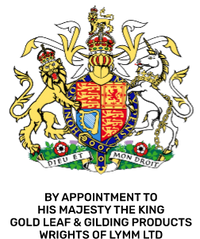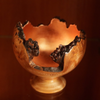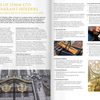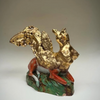Gold Leaf Across the World - Ireland
- by Sam Wozniak
The History and Uses of Gold Leaf in Ireland
Gold leaf has played a significant role in Ireland's artistic, religious, and monumental heritage. The tradition of gilding, which involves applying gold leaf to surfaces for decoration, dates back thousands of years. In Ireland, gold leaf has been utilized in a variety of contexts, from ancient artifacts to medieval manuscripts and modern architecture. The most commonly used gold leaf comes in 24 carat and 23.5 carat varieties, ensuring a high level of purity and brilliance.
Ancient Uses of Gold Leaf in Ireland
Ireland has a rich history of gold craftsmanship, particularly evident in prehistoric artifacts discovered across the island. The use of gold leaf dates back to the Bronze Age, around 2200–500 BCE, when skilled metalworkers created intricate gold jewellery and ceremonial objects. The famous Broighter Hoard, discovered in County Derry, includes stunning gold artifacts such as a boat, torcs, and bowls, some of which exhibit early gilding techniques. Although full sheets of gold leaf were not commonly used at this time, the principle of applying gold for decorative and symbolic purposes was already well established.
The Tara Brooch (circa 700 CE) is another example of early Irish craftsmanship. While it primarily features solid gold elements, the techniques used in its creation influenced later gilding methods. In early Irish society, gold was associated with divine power, royalty, and spiritual significance, making it a key material in sacred and monumental contexts.
Gold Leaf in Early Irish Manuscripts and Religious Art
During the early medieval period, gold leaf became an essential element in religious art, particularly in illuminated manuscripts. The Book of Kells, one of Ireland’s most treasured artifacts, features gold leaf embellishments that highlight intricate designs and religious iconography. Created by Irish monks around 800 CE, this manuscript exemplifies the use of gilding to enhance the sacredness and visual impact of texts.
Churches and monasteries across Ireland used 23.5 carat and 24 carat gold leaf for religious iconography, covering altars, crosses, and statues of saints. The incorporation of gold leaf into religious objects reinforced their spiritual significance and ensured their preservation over centuries.
Monumental Gilding in Ireland’s Architecture
Gold leaf has also been used in Ireland’s monumental structures, particularly in the decoration of government buildings, cathedrals, and public statues. One of the most famous examples of gilding in architecture is the Four Courts in Dublin, where gold detailing enhances the grandeur of this neoclassical building. Similarly, the dome of City Hall in Belfast features gold leaf accents that highlight the opulence of its design.
In recent years, gilding has been employed to restore historic monuments, ensuring that traditional decorative techniques continue to be part of Ireland’s cultural identity. Many statues in Dublin, such as the Daniel O’Connell Monument, incorporate gold leaf details to enhance their visibility and grandeur.
Modern and Contemporary Uses of Gold Leaf in Ireland
Today, gold leaf remains popular in Irish art, furniture restoration, and interior design. Skilled craftsmen use 24 carat and 23.5 carat gold leaf to create stunning decorative pieces, from gilded picture frames to luxury interiors. Irish contemporary artists also incorporate gold leaf into their work, blending traditional techniques with modern artistic expression.
Additionally, the culinary industry has embraced gold leaf for decorative purposes, with high-end restaurants in Dublin and beyond using edible gold leaf to embellish gourmet dishes.
Conclusion
Gold leaf has played a fundamental role in Irish history, from prehistoric artifacts and medieval manuscripts to monumental architecture and modern art. Whether in its pure 24 carat form or the slightly alloyed 23.5 carat version, gold leaf continues to symbolize wealth, divinity, and artistic mastery in Ireland. Through gilding, Ireland preserves its ancient traditions while adapting them for contemporary use, ensuring that the legacy of gold craftsmanship endures for future generations.






